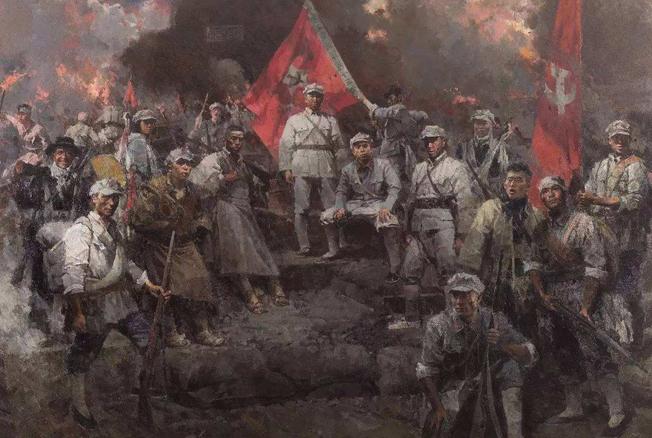If you want to understand why the three armies are missing, perhaps everyone will be clear from the beginning of the establishment of our Party's troops, because each period is different, and before the Liberation War, there were three organizational periods.
At first, the organization of the old army was followed, and the first workers' and peasants' armed forces were called the Fourth Army of the Chinese Workers' and Peasants' Revolutionary Army, because many of them were officers of the Fourth Army of the National Revolutionary Army who participated in the Nanchang Uprising, so they were slightly modified and used.

The word "Red Army" first appeared after the Jute Uprising, when the Huang'an calligrapher Wu Lanju wrote a couplet: "Hate the Green Forest Soldiers, pretend to be blue sky and white sun, and bury the naked son in darkness; restore Huang'an County, try to see the blue clouds and purple qi, and the Cangsheng Jiji support the Red Army." During the Guangzhou Uprising, the banner of the "Workers' and Peasants' Red Army" was unfurled.
On May 25, 1928, the Central Committee of the Communist Party of China issued a circular formally designating the Communist forces as the Red Army, abolishing the name of the former Workers' and Peasants' Revolutionary Army, and thus beginning a period of self-establishment. Later, the Red I, Red II, and Red IV Fronts and all the units under their jurisdiction belonged to this.
After the Japanese invaded China in an all-round way in 1937, for the sake of the national united front, the Red Army accepted reorganization and became the Eighth Route Army of the National Revolutionary Army, referred to as the Eighth Route Army. On September 11, the Nationalist government reorganized the major "route army" into "group armies" according to the order of battle of the national army, navy and air force, and the Eighth Route Army was later renamed the Eighteenth Group Army of the National Revolutionary Army.
In October 1937, the Nationalist government reorganized the 15 guerrilla zones of the Communist Party of China into the newly organized Fourth Army of the National Revolutionary Army, referred to as the New Fourth Army. This was also the period of the Formation of the National Revolutionary Army.
In the period of the War of Liberation, it was naturally impossible for our Party to use the Kuomintang's organization, and for the sake of the great cause of liberation, the whole country was divided into strategic areas, and the strategic areas generally used field "columns" as the main organization. At that time, the organization was relatively chaotic, and the column had 2 to 3 divisions (brigades) under its jurisdiction, and the number was different.
In November 1948, the Central Military Commission issued a circular order, and the field army began to implement a unified regular organization, the column was renamed the army, the division and brigade were uniformly called the division, and two levels of corps and field army were set up above the army level. (The local military unit system belongs to the military district system)
The four field armies are distinguished by place names: the Northwest Field Army, the Central Plains Field Army, the East China Field Army, and the Northeast Field Army. In addition, there is a North China Field Army, which is relatively special and is only a direct subordinate unit of the North China Military Region in the strict sense.
According to the combat objectives and geographical locations of the major field armies, the number of corps allocated is also different: two in the northwest, four in the Central Plains, five in East China, six in the Northeast, and three in North China.
At the time of reorganization, there were 55 columns and 168 divisions (brigades), and in consideration of the subsequent war, the 210 divisions of 70 armies were planned.
After the liberation of Peiping, the central government found that it was no longer appropriate to distinguish the field army by place name, so it once again changed the name and called it the First to Fourth Field Army. Since then, 67 armies have been formed successively, and only the 56th, 57th, and 59th Armies have not been formed.
The establishment of these three armies was originally prepared for the Northeast Field Army, that is, Siye, but after entering the customs, the situation was already relatively clear, and Siye thought that the scale of the operation would not be too large, so there was no need to use so many numbers, and the 51st to 57th Armies were all prepared for Siye, and it was useless.
Later, the 51st to 53rd Armies were given to the rebel troops of Cheng Qian, Zhang Yi, Chen Mingren and others, the 58th Army and the 59th Army were given to Nakano, and the 58th Army was used. However, because the speed of liberation was too fast, the 12th Column of the Jianghan Military Region, which was originally to be reorganized into the 59th Army, was directly merged with other units to form the Hubei Military Region, so the 59th Army was vacated.
Later, the 54th Army was used during the War to Resist US Aggression and Aid Korea, and the 55th Army was also used to guard the south, and then there was no major war, the troops were abolished a lot, and the 56th, 57th, and 59th Armies never had the opportunity to play again, and they also became the only three units in the history of the People's Liberation Army that had not been organized.
The organization of the army has appeared in line with the times, and even now it has changed several times, and it has begun to appear in the situation of the group king, so do you understand this?